Abstract
In this paper isothermal, isoperibolic and adiabatic calorimeters and a Power-Compensating DSC are compared by determining kinetic data of a simple test reaction. First, the kinetic parameters were analyzed using a conventional isothermal method, based on the analytic determination of the course of reaction. Subsequently, the kinetic data of the performed reaction were determined for the different types of calorimeters by simultaneously evaluating several measurements with identical initial conditions but different temperature courses. The kinetic parameters obtained by the different calorimeters agree reasonable well, indicating the reliability of kinetic data derived from thermokinetic methods.
Similar content being viewed by others
Abbreviations
- A/m2:
-
heat exchange area
- CA0/mol l−1:
-
initial concentration of compoundA
- CPIC,0/mol l−1:
-
initial concentration of phenyl isocyanate
- CBuOH,0/mol l−1:
-
initial concentration of 2-butanol
- E/J mol−1:
-
activation energy
- h/s:
-
isothermal equivalent reaction time
- ΔH/J mol−1 :
-
heat of reaction, reaction enthalpy
- k/l mol−1 s−1:
-
reaction rate constant (units corresponding to a second order reaction)
- λ:
-
ratio of initial concentrations λ=C PIC,0/C BuOH,0
- n :
-
reaction order of phenyl isocyanate and 2-butanol
- npic,0/mol:
-
initial amount of phenyl isocyanate
- νA :
-
stoichiometric coefficient of compoundA
- mcp/J K−1:
-
heat capacity of the whole system (reaction mixture and reactor)
- Φ(X):
-
conversion dependent term of reaction rate
- Q/W:
-
heat power caused by the chemical reaction
- Qch/W:
-
heat power of the chemical reaction
- Qbas/W:
-
baseline (heat power of the
- r(X,T)/mol 1−1 s−1:
-
reaction rate
- r(0,TR)/mol l−1 s−1:
-
initial reaction rate at a reference temperatureT r
- τ/s:
-
time lag constant
- t/s:
-
reaction time
- T/K:
-
temperature of reaction mixture
- T0/K:
-
initial temperature
- Te/K:
-
final temperature
- TK/K:
-
cooling temperature
- ΔT max/K:
-
maximum temperature rise under adiabatic conditions
- U/W K−1 m−2:
-
heat transfer coefficient
- X :
-
conversion
References
W. Köhler, O. Riedel and H. Scherer, Chem. Ing Tech., 44 (1972) 1216.
G. Höhne, W. Hemminger and H.-J. Flammersheim, “Differential Scanning Calorimetry”, Springer-Verlag Berlin Heidelberg 1996.
T. Grewer, “Thermal hazards of chemical reactions”, Elsevier Amsterdam 1994.
S. Wagner, Dissertation, Technische Universität Berlin 1996.
A. M. Angelidou and P. Hugo, Chem. Ing. Tech., 62 (1990) 741.
P. Hugo and G. H. Pham, Chem. Ing. Tech., 61 (1989) 635.
H. J. Borchards and F. Daniels, J. Am. Chem. Soc., 79 (1957) 41.
E. S. Freeman and B. Carrol, J. Phys. Chem., 62 (1958) 394.
J. Opfermann and E. Kaiserberger, Thermochim. Acta, 203 (1992) 167.
P. Hugo, Chem. Ing. Tech., 65 (1993) 1497.
J. Mentel and H. Anderson, Thermochim. Acta, 187 (1991) 121.
A. I. Benin, A. A. Kossoy and P. U. Smykalov, J. Thermal Anal., 38 (1992) 1151.
P. Hugo, J. Leonhardt and S. Wagner, Z. Naturforschung, 50a (1995) 549.
P. Hugo, J. Leonhardt and S. Wagner, “Sichere Handhabung chemischer Reaktionen”, Praxis der Sicherheitstechnik Vol. 3, Dechema Frankfurt am Main 1995, 79.
Author information
Authors and Affiliations
Additional information
The authors are thankful for the financial support by the Department of Education and Research of the Federal Republic of Germany (BMBF).
Rights and permissions
About this article
Cite this article
Leonhardt, J., Hugo, P. Comparison of thermokinetic data obtained by isothermal, isoperibolic, adiabatic and temperature programmed measurements. Journal of Thermal Analysis 49, 1535–1551 (1997). https://doi.org/10.1007/BF01983714
Issue Date:
DOI: https://doi.org/10.1007/BF01983714



